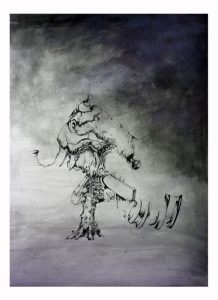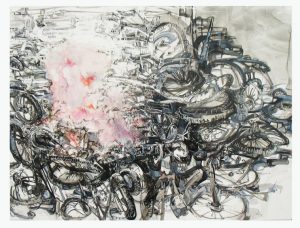Deadline Approaching: Artist Opportunity Grants (January 2) >>> More Info



A look at some of April Loveday’s drawings is a bit like inspecting the peculiar creations of a Dr. Seuss or a Tim Burton – detailed sketches, some punctuated by color, others heavy with lines and cross-hatches, portray mutants that comprise combinations of man, animal, vegetation, machine and discarded objects.
Her drawings, rendered in pen, ink and wax on paper, rely not on tracing or projections, and her source material typically is her mind.
Loveday, 34, lately has become more interested in the relationship between figuration and abstraction, about how malleable perception can be. Her work as a vision therapist, she says, “has given me insight into the way our sense of sight is developed in terms of both the eyes and the brain.”

Loveday works with children and adults who have compromised binocularity, which is caused by an eye turn, suppression or brain injury. Specific physical and mental activities help patients regain or develop three-dimensional vision.
“Spending so much time thinking about the physical and perceptual qualities of sight and the variation of personal experience,” she says, “has had a big impact on my artwork.”
The Division’s fellowship will help her continue honing her craft and has brought to her a deeper sense of connection to Delaware’s artistic community. Just as important to her, it has encouraged her to push herself to the next level.
“The past year and a half, I have been working more often in collaboration with other artists in addition to making my own work,” Loveday says, “and although it can bring up a lot of challenges, it has helped to revitalize the way I approach creative tasks.”
Her initial focus was on painting, but in time she was drawn to drawing. She liked the simplicity of the materials and the variety of methods of expression.
“It’s foundational without being basic,” Loveday says.

Lately, she has worked with collections of drawings rendered as animated shorts. Loveday enjoys experimenting – she has no sketch or plan from which to begin a drawing; she takes a general idea and leans on a color palette of her liking.
The Division’s grant, she says, comes at a crucial time. She is transitioning from an environment supportive of artists – in May 2010, she received her Masters of Fine Arts at the Pennsylvania Academy of the Fine Arts – to what most succinctly can be called the real world.
“Often, I think people don’t understand why many artists can spend so much time, energy and thought on work with no assurance of financial gain,” Loveday says. “The truth is I never felt like it was a decision I made but something I had to structure my life around. So it has been difficult to return to a full-time work schedule and see my art practice be relegated to late nights and early mornings.”
The grant will go toward supplies and equipment that will allow her to create work she has had in mind for several years.